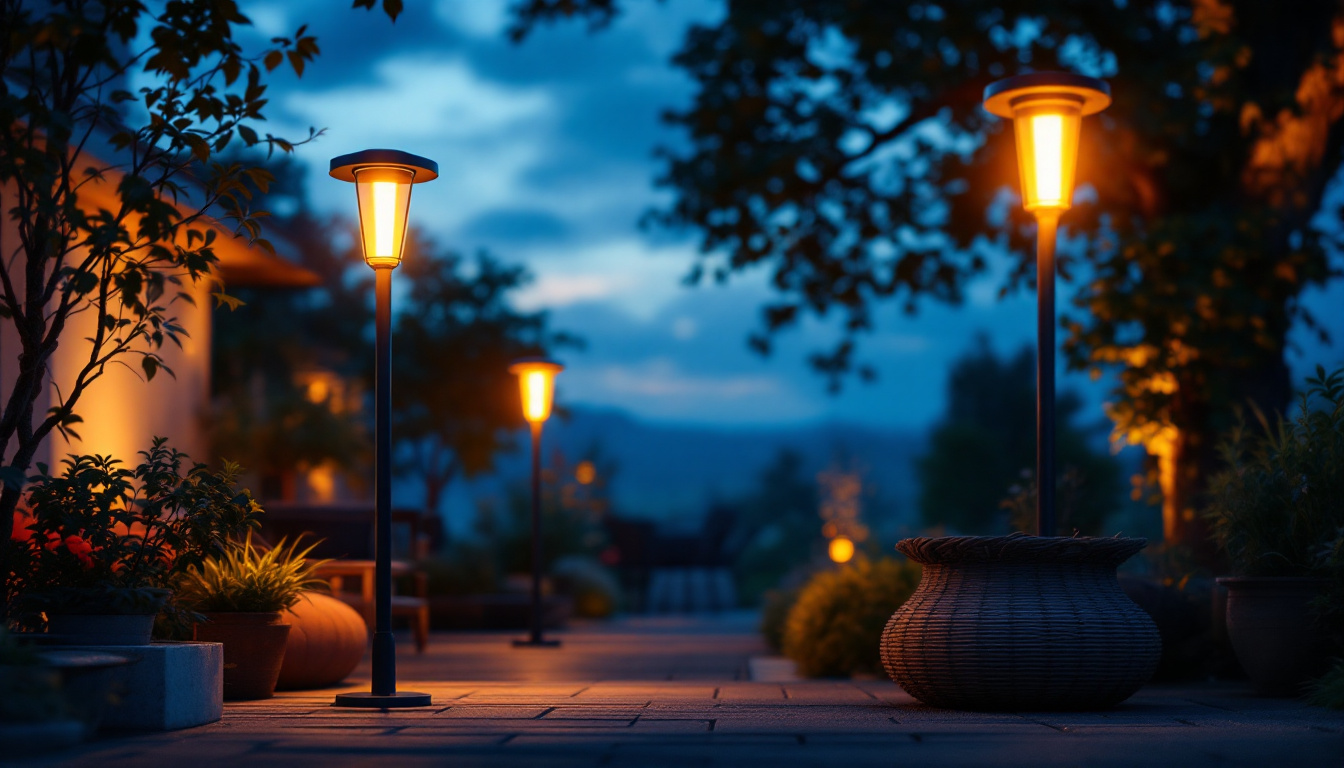
Outdoor flood lights serve as essential components in enhancing safety, security, and aesthetics for residential and commercial properties. For lighting contractors, mastering the intricacies of flood lighting can lead to increased client satisfaction and a robust portfolio. This article delves into the various aspects of flood outdoor lights, providing insights and tips for lighting contractors to excel in their projects.
Flood outdoor lights are designed to illuminate large areas, making them ideal for various applications, including parking lots, backyards, and building facades. Their broad beam angle and high-intensity output allow for effective lighting in expansive spaces, ensuring visibility and safety. These lights are not only functional but also play a significant role in enhancing the aesthetic appeal of outdoor environments, creating a welcoming atmosphere after sunset. With advancements in technology, modern flood lights can now be integrated with smart home systems, allowing users to control them remotely and set schedules for automatic operation.
Flood lights come in various types, each suited for different applications. The most common types include LED, halogen, and metal halide flood lights. LED flood lights are increasingly popular due to their energy efficiency and longevity, often lasting up to 50,000 hours, which significantly reduces the need for frequent replacements. Halogen lights provide a warm glow but consume more energy, making them less desirable for those looking to minimize electricity costs. Metal halide lights offer high-intensity illumination and are often used in large venues such as stadiums, although they may take time to warm up and can be less energy-efficient compared to their LED counterparts. Additionally, solar-powered flood lights are gaining traction, providing an eco-friendly option that harnesses renewable energy for outdoor lighting needs.
Flood lights are versatile and can be used in numerous settings. In residential areas, they illuminate driveways, gardens, and patios, enhancing the outdoor living experience. They are particularly useful for increasing safety and security around homes, deterring potential intruders with bright, well-lit spaces. In commercial settings, they provide security for parking lots and building perimeters, ensuring that employees and customers feel safe during evening hours. Additionally, flood lights are often used in sports facilities and outdoor events to ensure visibility during nighttime activities, allowing for everything from community soccer games to large concerts to proceed without interruption. Their robust design and powerful output make them a reliable choice for any outdoor lighting requirement.
When selecting flood lights, several key features should be considered. These include brightness, beam angle, color temperature, and durability. Brightness is measured in lumens, with higher lumens indicating brighter light, which is essential for areas that require enhanced visibility. The beam angle determines how wide the light spreads, with wider angles being suitable for general illumination and narrower angles focusing on specific areas. Color temperature affects the ambiance, with warmer tones creating a cozy atmosphere and cooler tones providing a more clinical, bright light. Durability is crucial, especially for outdoor installations, as lights must withstand various weather conditions, including rain, snow, and extreme temperatures. Look for flood lights with a high IP rating, indicating their resistance to water and dust, and consider options with adjustable mounting brackets for versatile positioning to maximize their effectiveness in illuminating your space.
Proper installation is vital for the effectiveness and longevity of flood lights. Lighting contractors must follow best practices to ensure that flood lights are installed correctly and safely. This section outlines essential installation tips and considerations.
Before installation, conducting a thorough site assessment is essential. This involves evaluating the area to determine the best locations for flood lights. Factors such as existing light sources, potential obstructions, and the intended purpose of the lighting should be considered. A well-planned layout will maximize the effectiveness of the flood lights and minimize unwanted shadows.
Flood lights can be mounted in various ways, including wall-mounted, pole-mounted, or ground-mounted options. The choice of mounting depends on the specific requirements of the project. Wall-mounted lights are ideal for illuminating building facades, while pole-mounted options are suitable for parking lots and open areas. Ground-mounted lights can create dramatic effects in landscaping.
Proper wiring is crucial for the safe operation of flood lights. Contractors should ensure that all electrical connections are secure and comply with local codes. It is advisable to use weatherproof fixtures and wiring to protect against moisture and other environmental factors. Additionally, incorporating timers or motion sensors can enhance energy efficiency and security.
Flood lights are not only functional but can also enhance the visual appeal of a property. Lighting contractors can leverage creative techniques to elevate the aesthetics of outdoor spaces.
One effective way to enhance aesthetics is by using flood lights to highlight architectural features. By strategically placing lights to illuminate columns, arches, or unique design elements, contractors can create a stunning visual impact. This technique not only showcases the property’s beauty but also adds depth and dimension to the landscape.
Flood lights can be utilized to create different moods and atmospheres. For instance, using warm-colored flood lights can create a cozy and inviting environment for residential patios and gardens. In contrast, cooler tones can be employed in commercial settings to convey a modern and professional ambiance. Adjusting the brightness and positioning of the lights can further enhance the desired effect.
Integrating flood lights with landscape design is essential for achieving a harmonious outdoor space. By coordinating the lighting with plants, trees, and pathways, contractors can create a cohesive look. For example, uplighting trees can create a dramatic effect, while downlighting along pathways ensures safety and guides guests through the space.
As the focus on sustainability continues to grow, lighting contractors must consider energy-efficient options for flood lighting. This not only benefits the environment but also appeals to clients who are conscious of energy consumption.
LED flood lights are the most energy-efficient option available, consuming significantly less energy than traditional halogen or metal halide lights. They also have a longer lifespan, reducing the need for frequent replacements. When selecting flood lights, contractors should prioritize energy-efficient models that meet or exceed industry standards.
Smart technology can enhance the energy efficiency of flood lighting systems. By integrating smart controls, such as timers, dimmers, and motion sensors, contractors can help clients reduce energy consumption. These technologies allow for automated adjustments based on usage patterns, ensuring that lights are only on when needed.
Lighting contractors can also promote sustainable practices by educating clients about the benefits of energy-efficient lighting. Providing information on the long-term cost savings and environmental impact of using LED flood lights can influence clients’ decisions. Additionally, encouraging the use of renewable energy sources, such as solar-powered flood lights, can further enhance sustainability efforts.
Regular maintenance is essential for ensuring the longevity and performance of flood lights. Lighting contractors should be prepared to offer maintenance services and troubleshooting tips to clients.
Conducting routine inspections of flood lighting systems can help identify potential issues before they become significant problems. Contractors should check for any signs of wear and tear, such as frayed wires or damaged fixtures. Cleaning the lenses and fixtures regularly can also improve light output and effectiveness.
Lighting contractors should be familiar with common issues that may arise with flood lights. These can include flickering lights, inconsistent brightness, or complete failure to illuminate. Understanding the potential causes, such as faulty wiring or burned-out bulbs, enables contractors to diagnose and resolve issues quickly.
Offering ongoing support to clients can enhance satisfaction and build long-term relationships. Providing clients with information on how to maintain their flood lighting systems and troubleshoot minor issues empowers them to take care of their installations. Additionally, offering maintenance contracts can ensure that clients receive professional support when needed.
The lighting industry is continually evolving, with new technologies and trends emerging regularly. Lighting contractors must stay informed to remain competitive and provide the best solutions for their clients.
Participating in continuing education and training programs can help contractors stay updated on the latest advancements in flood lighting. Many organizations offer workshops, webinars, and certification courses that cover new technologies, installation techniques, and energy-efficient practices. Investing time in education can enhance expertise and credibility in the field.
Networking with other lighting professionals can provide valuable insights into industry trends and best practices. Attending trade shows, conferences, and local meetups allows contractors to connect with peers, share experiences, and learn from one another. Building a strong network can lead to collaborations and referrals that benefit all parties involved.
Staying informed about new products and technologies is crucial for lighting contractors. Regularly researching manufacturers, reading industry publications, and following relevant online forums can help contractors discover innovative solutions for their projects. Embracing new products can enhance the quality of installations and provide clients with the latest options available.
Mastering flood outdoor lights is essential for lighting contractors looking to enhance their services and meet the diverse needs of clients. By understanding the various types of flood lights, installation best practices, aesthetic enhancements, energy efficiency, maintenance, and industry trends, contractors can position themselves as experts in the field.
As the demand for outdoor lighting solutions continues to grow, embracing these principles will not only improve client satisfaction but also contribute to the overall success of a lighting contracting business. By staying informed and adapting to changing technologies, lighting contractors can illuminate the path to success in the ever-evolving world of outdoor lighting.
Ready to take your flood outdoor lighting projects to the next level? At LumenWholesale, we provide lighting contractors with the highest quality, spec-grade lighting products at prices that can’t be beaten. Say goodbye to local distributor markups and hello to a vast selection of industry-standard, reliable lighting solutions. With the added benefits of free shipping and bulk buying made easy, LumenWholesale is your go-to source for premium lighting without the premium price tag. Elevate your lighting game and ensure every project shines with Wholesale Lighting at the Best Value. Start browsing our collection today and experience the LumenWholesale difference.

Illuminate your outdoor spaces with expert insights from lighting contractors.

Discover how LED work lights can revolutionize your projects by saving lighting contractors both time and money.

Discover the essential insights lighting contractors need to meet client expectations with 2 ft LED light fixtures.

Discover how solar pole lights are revolutionizing outdoor lighting with their eco-friendly and cost-effective benefits.